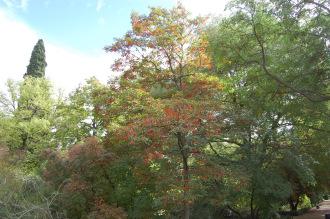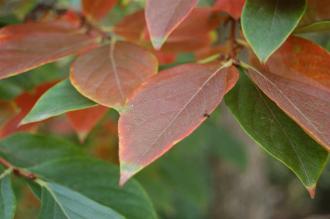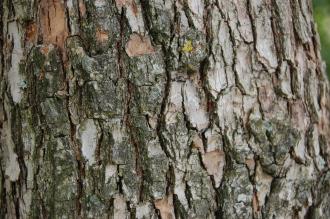
Diospyros kaki Autumn (18/10/2014, Real Jardín Botánico de Madrid)
Position: Full sun to partial shade
Flowering period: Late spring
Soil: Moist, well drained
Eventual Height: 10m
Eventual Spread: 7m
Hardiness: 7a, 7b, 8a, 8b, 9a, 9b
Family: Ebenaceae
Diospyros kaki is a deciduous tree with a rounded habit. Its mid to dark green leaves are ovate with entire margins, up to 20cm long and 10cm wide. Its leaves turn red/ yellow before they fall in autumn. Its brown/ grey bark forms scaly platelets as the tree matures. This tree is dioecious and both a male and female tree must be grown for the female to produce fruit. Its flowers are up to 25mm across, with the male being pink and the female being cream in colour. Its yellow/ orange fruit are ovoid up to 8cm across, ripen in October to November and are edible.

Diospyros kaki Autumn Leaf (18/10/2014, Real Jardín Botánico de Madrid)
Diospyros kaki, commonly known as the Japanese Persimmon, Kaki Persimmon or Asian Persimmon, is native to south west Asia including the Himalayas and Caucasus mountains. In its native habitat it grows as part of a mixed deciduous forest. This tree has been cultivated in China for more than 2000 year.
The etymological root of the binomial name Diospyros is derived from the Greek dios meaning ‘heavenly’ and purinos meaning ‘wheat’. Kaki is derived from the vanacular name for this tree in Japan.
The landscape architect may find useful Diospyros kaki as edible fruiting tree as part of a community or wild life garden.

Diospyros kaki Autumn Bark (18/10/2014, Real Jardín Botánico de Madrid)
Ecologically, Diospyros kaki fruit are attractive to birds and mammals (including humans).
Diospyros kaki prefers moist, deep loamy, well-drained soils. It tolerates most pH of soil.
Diospyros kaki requires little maintenance.

